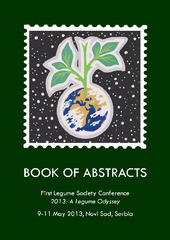Приказ основних података о документу
Evaluation of bean and snap bean populations collected on western part of Fruska gora Mt.
| dc.creator | Savić, Aleksandra | |
| dc.creator | Zdjelar, Gordana | |
| dc.creator | Milošević, Mirjana | |
| dc.creator | Nikolić, Zorica | |
| dc.creator | Petrović, Anamarija | |
| dc.creator | Gvozdanović-Varga, Jelica | |
| dc.creator | Bošković, Olgica | |
| dc.creator | Vasić, Mirjana | |
| dc.date.accessioned | 2022-07-28T11:18:48Z | |
| dc.date.available | 2022-07-28T11:18:48Z | |
| dc.date.issued | 2013 | |
| dc.identifier.isbn | 978-86-80417-44-8 | |
| dc.identifier.uri | http://fiver.ifvcns.rs/handle/123456789/2939 | |
| dc.description.abstract | Seed of old varieties is an important source of genetic variability and plants adaptability. Broad genetic diversity is the base for successful breeding processes and adaptations to various environmental conditions and pathogens. In last five to six decades disappearance of old cultivars has been accelerated, mainly due to introduction of new cultivars based on principles of modern genetics into agricultural production. There was a cessation of cultivated plants previously used, and agricultural production and human diet is based on four main crops: wheat, corn, rice and potatoes. Large arable areas have been planted with single genotype of newly created cultivars resulting in great genetic impoverishment, especially, of the most cultivated plants. In that way, certain traits, particularly those connected with high yield, have been favored. Thus, the maintenance and evaluation of old cultivar’s seeds have been recognized as extremely important for all of humanity and its future. The research presented in this paper has been conducted on the territory of southwestern Fruska gora Mt. as a part of the project „Za Vojvodjanskog paora” (2011-2012) financed by Provincial Secretariat for Science and Technological Development, Republic Serbia. Considering the extreme importance of Fruska gora Mt. for Vojvodina Province and the ongoing Master Plan for the mountain’s Sustainable Development, idea of the project was to collect seeds and planting material of crops, vegetables and wild plants and to examine the state of the mountain’s genetic resources. Of all the collected samples during the project, 14 samples of snap beans and 21 samples of beans have been analyzed in this paper. For all the accessions, 1000-seed mass, seed color, seed shape and phaseolin type was determined. Seed color was determined visually. Based on the ratios of: (i) seed length and seed width, and (ii) seed thickness and seed width, collected seed samples were classified into five basic groups of seed shape: round, ellipsoid, cylindrical, semi-flat and kidney-shaped. Seeds of collected bean samples have three, while snap bean seeds have four different shapes, and none of them was round. Seed coats of bean accessions were of five different colors, while in the snap bean group seed coats were of three different colors. Seeds of collected bean and snap bean accessions were predominantly white and cylindrical in shape. Mass of 1000 seeds ranged between 104.9 and 634.96 g. Averaged 1000-seed mass of bean accessions was 379.44g. Snap beans had smaller seed, with 247.98 g of 1000-seed mass in average. T phaseolin type dominated, while S type of phaseolin was present in six bean samples, and in snap bean accessions numbered NK2/12 and NK40/12. T phaseolin type was mostly present in seeds of snap beans that were white, while no significant correlation between seed color and phasolin type was determined in the beans. | sr |
| dc.language.iso | en | sr |
| dc.publisher | International Legume Society | sr |
| dc.publisher | Novi Sad : Institute of Field and Vegetable Crops | sr |
| dc.relation | info:eu-repo/grantAgreement/MESTD/Technological Development (TD or TR)/31030/RS// | sr |
| dc.relation | APV 114-451-3139/2011-01: For the Vojvodina Farmer, financed by the Provincial Secretariat for Higher Education and Scientific Research, AP Vojvodina | sr |
| dc.rights | openAccess | sr |
| dc.rights.uri | https://creativecommons.org/licenses/by/4.0/ | |
| dc.source | Book of Abstracts, 1st Legume Society Conference 2013: A Legume Odyssey, 9-11 May 2013, Novi Sad | sr |
| dc.subject | beans | sr |
| dc.subject | snap beans | sr |
| dc.subject | populations | sr |
| dc.subject | seeds | sr |
| dc.subject | Fruška gora | sr |
| dc.subject | old varieties | sr |
| dc.subject | heirloom cultivars | sr |
| dc.subject | genotypes | sr |
| dc.subject | accessions | sr |
| dc.subject | Serbia | sr |
| dc.title | Evaluation of bean and snap bean populations collected on western part of Fruska gora Mt. | sr |
| dc.type | conferenceObject | sr |
| dc.rights.license | BY | sr |
| dc.citation.epage | 37 | |
| dc.citation.spage | 37 | |
| dc.identifier.fulltext | http://fiver.ifvcns.rs/bitstream/id/8221/LSC1_pasulj.pdf | |
| dc.identifier.rcub | https://hdl.handle.net/21.15107/rcub_fiver_2939 | |
| dc.type.version | publishedVersion | sr |


